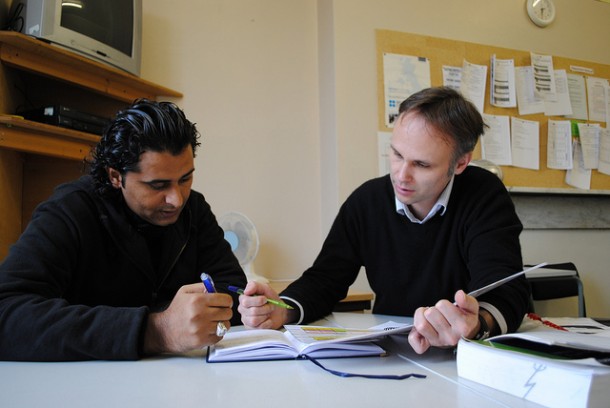SPAIN. Each year more and more Spaniards are seriously considering learning English, or taking a course to brush up on their current skills. English language knowledge has become essential to most European countries, as it is almost always the language used for communication among EU countries, international business, high level university study, and is also necessary for the tourism industry. Yet Spanish speakers repeatedly make the same mistakes when learning English, often despite having an advanced level. English teachers must be on the lookout for these common mistakes, and how to correct them early on.

Private lessons are a good way to make money | shaneglobal.
5 Common Errors Spanish Speakers Make Learning English
These five mistakes are some of the most common errors Spanish speakers make when learning and practicing English. English teachers in Spain should come ready to correct these mistakes and make sure to reinforce their correct usage.
1. Pronunciation
Spanish speakers make a lot of errors with pronunciation. Some advanced students know English grammar quite well, but can barely hold a conversation due to their incorrect pronunciation of key words. The following are some of the most common pronunciation errors that Spanish speakers make in English:
- Adding an “e” sound before words that begin with “s”. For example, a Spanish speaker would pronounce “special” as “especial”.
- Pronouncing a “y” as a “j”. For example, a Spaniard may say “jam” when reading the word “yam”.
- Pronouncing a “j” as an “h”. For examples, a student might pronounce the name “Jerry” as “Herry”.
2. Directly translating a preposition
Prepositions are tricky because they often change a lot between English and Spanish. Here are some specific examples of confusing prepositions.
- A Spanish speaker may say, “It depends of” instead of “It depends on”
- A Spanish student might say, “Call to someone” instead of “Call someone” (in English there is no preposition).
- Spaniards often incorrectly say, “Marry with somebody” instead of “Marry somebody” (in English there is no preposition).
3. False Cognates

Taking notes is vital when learning a languag | sterlic.
Also known as false friends, false cognates are words that appear to have the same meaning in both English and Spanish, but in reality are quite different. Here are three well-known false friends between English and Spanish:
- Embarazada: Looks like “embarrassed” but means “pregnant”.
- Actualmente: Looks like “actually” but means “currently”.
- Carpeta: Looks like “carpet” but means “folder”.
4. Order of adjectives and nouns
In Spanish, the noun generally comes before the adjective, while in English it is usually the opposite.
Example:
- Spanish: La casa verde (Direct translation: The house green)
- English: The green house
5. Confusion between “to do” and “to make”
In Spanish “hacer” is the verb that represents both “to do” and “to make” in English. It is often difficult for native Spanish speakers to remember which verb to use when speaking English. Some common mistakes include:
- “I need to do my bed” instead of “I need to make my bed”.
- “Can I do a suggestion?” instead of “Can I make a suggestion?”
- “Could you make me a favor?” instead of “Could you do me a favor?”
These are only some of the most common mistakes Spanish speakers make in English. Teachers should definitely come prepared to face these and other common errors, and should place great importance on correcting them in addition to learning new skills and concepts.

